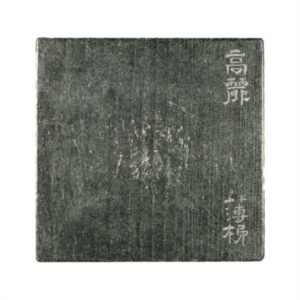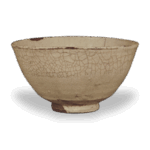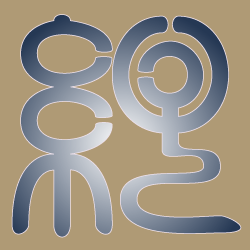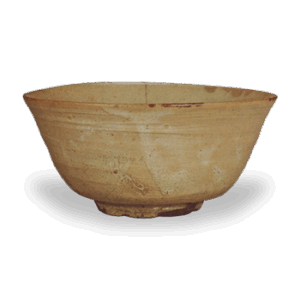


Accessories: Box, Kiriharu-nuri lacquerware with gold-leaf lettering, inscription by Kobori Jūzaemon
Provenance: Kobori Enshū → Tsuchiya Sagami-no-kami → Tennojiya Chūbei → Fujita family
References: Enshū Zōchō (Enshū’s Inventory), Tsuchiya Zōchō (Tsuchiya’s Inventory), Fujita Family Tools Register, Kikunoya Hikojiro’s “Kansō Zasshi,” “Toyotomi Hideyoshi’s 300th Anniversary Grand Tea Ceremony Record,” “Taisho Meiki Kan” (Taisho Era Masterpiece Guide)
Dimensions
Height: 8.2 cm Mouth diameter: 14.0–14.6 cm Foot diameter: 5.4 cm Same height: 1.0 cm Weight: 346 g
Owner: Osaka Fujita Museum of Art
This tea bowl, known as a “tamagote” (egg-shaped) tea bowl, is said to be a type of “katate” (firm-textured) tea bowl. This tea bowl resembles katate in terms of its clay, shape, and glaze. However, the glaze has a slightly yellowish white color, which distinguishes it from katate, and this is why it is also called tamagote. The glaze of this tea bowl is made by mixing feldspar with clay ash, and it is likely that the coloration was achieved due to firing in an oxidizing atmosphere. If it had been fired in a reducing atmosphere, the glaze would have taken on a bluish hue, resembling the style of the Katan-de tea bowl. The same applies to the Ito-yu tea bowl.
Tamagote tea bowls are extremely rare, making comparison difficult, but the clay is fine white clay, and those with a fire color from the firing are considered good. The rim has a slight outward curve, and the foot is made of bamboo joints, which are considered typical features. They are similar to tea bowls from Kumagawa and Kantei. This tea bowl has a large mirror on the inside, and the traces of layered firing add to its beauty.
Box: Paulownia wood, Haru-kei lacquer, gold powder lettering, signed by Kobori Jūzaemon.








